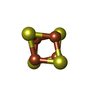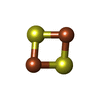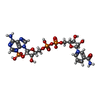+Search query
-Structure paper
| Title | Structure of mammalian respiratory complex I. |
|---|---|
| Journal, issue, pages | Nature, Vol. 536, Issue 7616, Page 354-358, Year 2016 |
| Publish date | Aug 18, 2016 |
 Authors Authors | Jiapeng Zhu / Kutti R Vinothkumar / Judy Hirst /  |
| PubMed Abstract | Complex I (NADH:ubiquinone oxidoreductase), one of the largest membrane-bound enzymes in the cell, powers ATP synthesis in mammalian mitochondria by using the reducing potential of NADH to drive ...Complex I (NADH:ubiquinone oxidoreductase), one of the largest membrane-bound enzymes in the cell, powers ATP synthesis in mammalian mitochondria by using the reducing potential of NADH to drive protons across the inner mitochondrial membrane. Mammalian complex I (ref. 1) contains 45 subunits, comprising 14 core subunits that house the catalytic machinery (and are conserved from bacteria to humans) and a mammalian-specific cohort of 31 supernumerary subunits. Knowledge of the structures and functions of the supernumerary subunits is fragmentary. Here we describe a 4.2-Å resolution single-particle electron cryomicroscopy structure of complex I from Bos taurus. We have located and modelled all 45 subunits, including the 31 supernumerary subunits, to provide the entire structure of the mammalian complex. Computational sorting of the particles identified different structural classes, related by subtle domain movements, which reveal conformationally dynamic regions and match biochemical descriptions of the 'active-to-de-active' enzyme transition that occurs during hypoxia. Our structures therefore provide a foundation for understanding complex I assembly and the effects of mutations that cause clinically relevant complex I dysfunctions, give insights into the structural and functional roles of the supernumerary subunits and reveal new information on the mechanism and regulation of catalysis. |
 External links External links |  Nature / Nature /  PubMed:27509854 / PubMed:27509854 /  PubMed Central PubMed Central |
| Methods | EM (single particle) |
| Resolution | 4.27 - 5.6 Å |
| Structure data | EMDB-4032, PDB-5lc5: |
| Chemicals |  ChemComp-SF4:  ChemComp-FES:  ChemComp-FMN:  ChemComp-NAP:  ChemComp-ZN: |
| Source |
|
 Keywords Keywords | OXIDOREDUCTASE / NADH:ubiquinone oxidoreductase / multienzyme complexes / Complex I / mitochondria |
 Movie
Movie Controller
Controller Structure viewers
Structure viewers About Yorodumi Papers
About Yorodumi Papers










